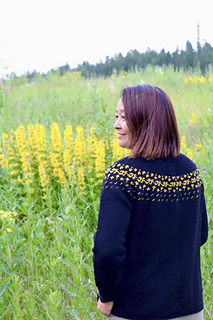patterns >  Woolen Tales' Ravelry Store
Woolen Tales' Ravelry Store
> Hanafubuki Cardigan






















Hanafubuki Cardigan
Hanafubuki - 花吹雪
Petal rain: when a gust of wind makes many petals fall at once and they resemble a snowstorm.
One of the pleasures we cherish most at home is to stroll the paths that wind through the neighbouring hills, in the typical Mediterranean forest. It is common to find oaks and holm oaks, alder trees, and hazelnut groves. However, in the fields surrounding an old farmhouse, stands a single and solitary cherry tree, which I have a special fondness for. Every spring we visit it, witness its blossoming and, when the time comes, we contemplate how the wind undresses its branches… a shower of petals carried by the wind with a fairy beauty that speaks of how ephemeral and treasurable life is.
In Japanese, there is a wonderful word to describe this shower of petals: Hanafubuki. It is composed of hana 花 (flower) and fubuki 吹雪 (blizzard or snowstorm). It literally means “flower blizzard.” It names the phenomenon of a group of flowers falling together from the tree because of a gust of wind. Like a gale of flowers, hence the name hanafubuki or “flower blizzard”.
This beautiful Japanese word is closely related to the word Sakura, the Japanese word for “cherry tree”. The reason is that Hanafubuki is used especially to refer to the rain of Sakura petals caused by spring winds, which is quite a visual spectacle. The sakura kanji itself is one of the most beautiful characters in Japanese. It is composed of the tree radical 木, water drops 水 and woman 女.
Hanafubuki cardigan is a circular yoke that is worked seamlessly from the top down. The neck is worked first, after that, several series of short rows are used for a comfortable and beautifully shaped finish.
The yoke is shaped with increases that are evenly distributed around the entire circumference of the upper body and followed by some raglan increases.
Sleeves are then placed on hold and the body is worked toward the hem. The sleeve stitches are then placed on the needles again and worked in the round toward the cuffs.
The cardigan is relaxed fit and as it is knitted top-down lengths are easily adaptable.
The cardigan is steeked. The front steek is not cut open until after the body and sleeves are completed to allow the cardigan to be held together neatly during the knitting of the latter. The garment should be tried on before cutting to ensure a good fit.
Beginner-friendly as you only work with 2 colors at a time.
Please, read carefully the whole pattern before you start knitting. As the pattern gives detailed calculations for all sizes, I recommend highlighting all numbers related to your size in order to have an easy overview of the pattern.
Sizes 1 (2, 3, 4, 5, 6, 7, 8, 9, 10, 11)
Bust circumference of the finished sweater: 80 (90, 97, 105, 115, 122, 130, 137, 150, 159, 172.5) cm / 31½ (37½, 38¼, 41¼, 45¼, 48, 51¼, 54, 59, 62½, 68)’’. The cardigan is designed to be worn with approximately 5 cm / 2’’ of positive ease.
Model has 85 cm / 33½’’ bust, stands 164 cm / 64½’’ and is wearing size 2.
FINISHED MEASUREMENTS
A = Bust circumference
B = Yoke depth
C = Length from armhole to lower edge
D = Sleeves length (from underarm)
E = Armhole circumference
F = Cuff circumference
Yarn
Super Soft by Holst Garn 50 g = 287 m / 314 yds
Sample shown in:
MC - Denim — 895 (957, 1051, 1173, 1239, 1288, 1356, 1433, 1485, 1540, 1595) m / 979 (1047, 1150, 1283, 1355, 1409, 1483, 1568, 1624, 1684, 1744) yds
CC - Leather — 66 (70, 75, 80, 86, 92, 98, 105, 120, 135, 150) m / 72 (77, 82, 88, 94, 101, 107, 115, 131, 147, 164) yds
Needles
3 mm / US 2½ circular needle 24”/60 cm or 32”/80 cm and 3,5 mm / US 4 circular needle 24”/60 cm or 32”/80 cm
Notions
6 stitch markers (one different for BOR) • waste yarn for holding the sleeve stitches • tapestry needle to weave in the yarn ends • 6 — 8 buttons 5/8 inch / 1.5 cm diameter (optional you may need 6 — 8 stitch markers to mark the buttonholes) • 60’’ / 150 cm long decorative ribbon for lining the button/buttonhole bands (optional) • sewing thread for sewing down the cut steek edges • scissors
Gauge
24 sts x 32 rows — 10 cm / 4’’ in stockinette with 3,5 mm / US 4 needles, after blocking.
24 sts x 32 rows — 10 cm / 4’’ in colorwork with 3,5 mm / US 4 needles, after blocking.
41354 projects
stashed
42570 times
- First published: September 2022
- Page created: September 2, 2022
- Last updated: May 26, 2024 …
- visits in the last 24 hours
- visitors right now





